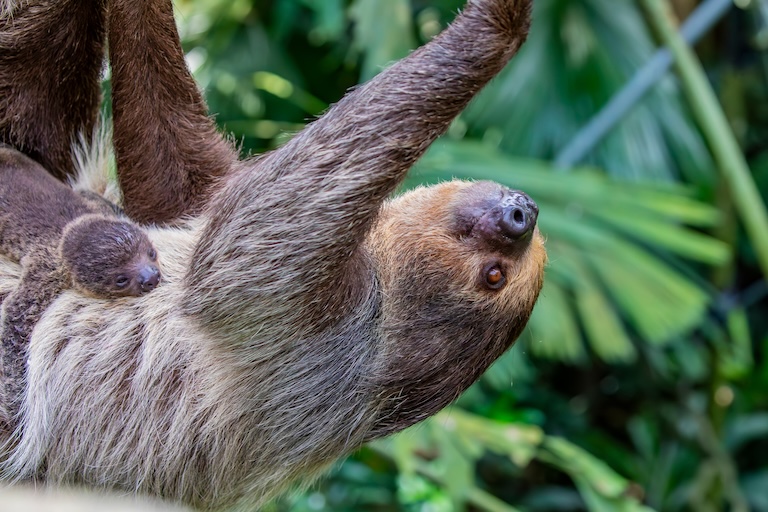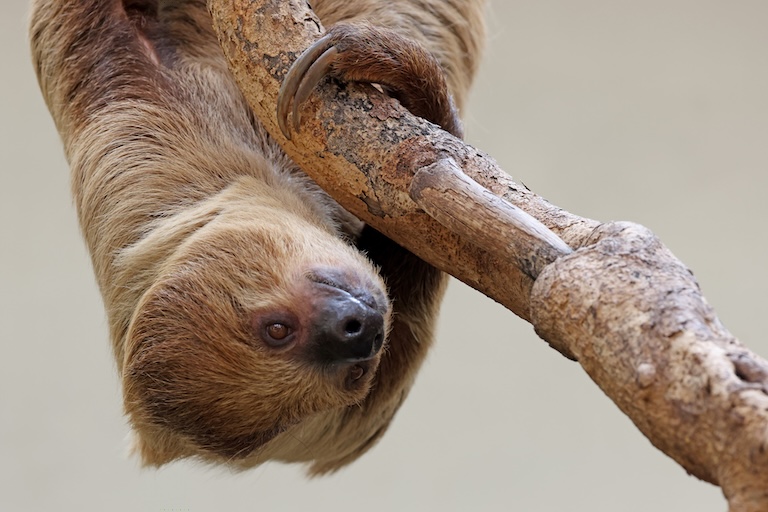Unau Profile
1997 was the year when the stars of multimedia aligned. Song 2, Fifth Element, Fallout 1, and South Park are just a sprinkling of enduring examples of stuff that showed up that year.
But a now mostly forgotten cartoon from Britain told the tale of a whole community of animals on a floating island, navigated across the empty ocean by a polar bear called Noah. Noah’s Island was a surreptitiously Catholic take on a real event: the separation of South Africa from Gondwana.
And this very real event is how we ended up with some totally unreal animals like this one: Linnaeus’ two-toed sloth, or the Unau.

Unau Overview
| Habitat: | Arboreal, tropical rainforest |
| Location: | South America |
| Lifespan: | More than 28 years in captivity |
| Size: | Up to 74 cm (29 inches) long |
| Weight: | Up to 8 kg (15 lb) |
| Colour: | Brownish grey, usually with a coating of green moss/algae |
| Diet: | Mostly leaves, some fruits, occasionally insects |
| Predators: | Harpy Eagles, Felids |
| Top Speed: | It’s a sloth |
| No. of Species: | 1 |
| Conservation Status: | Least Concern |
Linnaeus’ two-toed sloth is one of two species in the two-toed sloth family. A family with some fascinating genealogy. They have 50% more toes than their name might suggest, and they’re pretty chill, literally, hanging upside down in the rainforests of South America. Here, they have become ecosystems of their own, and as popular as they are, they remain pretty poorly understood and a great place for budding zoologists to focus their dissertations, as a result.
Interesting Unau Facts
1. They’re related to anteaters
Sloths are mammals that got cut off from the supercontinent Gondwana and drifted into the ocean alone on an Island continent before bears, let alone polar bears, even existed. For around 30 million years, the animals in South America followed their own evolutionary journeys and became unique, and the superorder Xenartha, including the anteaters, sloths and armadillos, are prime examples of this.
Xenartha comes from the Greek for Alien, and so, this unique bunch are well named, but the order Pilosa separates away the Armadillos and retains the sloths and the anteaters as the closest related members.
Sloths themselves used to make up almost ten known families, but today there are just two. The Bradypodidae contains the five species of three-toed sloths, and the Choloepodidae contains the remaining two species of two-toed sloths. Unsurprisingly, the Unau, or Linnaeus’ two-toed sloth, is found in the latter. But perhaps more surprisingly, is that it doesn’t have two toes at all.

2. They have three toes
If we consider toes to be the digits found on the rear limbs of an animal, the Unau has three toes. The two-toed common name refers to the digits on the forelimbs, which are three in number for the Bradypodidae group, and only two in this one, the Choloepodidae. So really, they’d be better called two-fingered sloths, and this error is plenty of justification for the Unau to give you the two fingers, but it never would, because it’s such a chill animal.
3. They’re cool
Sloths are weird in so many ways, but one great example is how they manage body temperature issues. In humans, internal temperature is kept within about 2 degrees at all times of day, in any weather. This is metabolically expensive and requires an intricate system of checks and balances to maintain, like sweating, shivering, rerouting blood supply, and all that.
Sloths are less worried about these things, and are one of the few mammals to allow their body temperature to rise and fall with the ambient temperature, at least to a huge degree by mammalian standards.
Anything below around 35 to 36 degrees Celsius and we’re in hypothermia territory. But for sloths, this is their default temperature, and they can, in fact, drop well below this. When resting in a state of torpor, they’ve been measured reaching body temperatures as low as 20 degrees!
This is remarkably cool for a mammal, and much more commonly found in reptiles, but sloths are just cool like that. And this isn’t the only reason.
4. It gets even cooler
You might have wondered how the sloths of the world can be so distantly related to be separated at the family level, whilst looking so remarkably alike. The typical sloth phenotype evolved in both families, but more or less independently.
Because a while back, before South America connected with North America, sloths were everywhere. Among the 8 known families were creatures like the Megatherium, a monstrous group of giant ground sloths that could stand on two legs and impale terror birds with a thumb spike.
Another family of ground sloth was the Mylodontidae, who even migrated into North America before going extinct, and were lumbering, quadrupedal, armoured variants of the sloth line.
And it is from this very line that the Unau evolved, retreating to the canopy to avoid the influx of Carnivoran predators from the North around 5 million years ago, and surviving as a lone member of an ancient “order” of sloth kind. So, the two-toed sloths are essentially arboreal ground sloths.
And that’s perhaps the coolest thing about them. 1

5. Weird cervix
Usually, mammals have seven cervical, or neck, vertebrae. You should, as should a mouse and a giraffe. But there are a couple of exceptions in the animal kingdom. One is the manatee, but they’re weird enough for their own essay; the other is the sloth.
And perhaps even stranger is that even sloths have 7 cervical vertebrae most of the time. It’s just that they often don’t, too. Some have been found to have as few as five, and others as many as 9. The Unau is one species that typically deviates to the lower end of this spectrum, while three-toed sloths go the other way.
This number doesn’t change after birth, but it is a peculiar example of common mutations that don’t seem to really cause much trouble for the species, and probably have some benefit that nobody’s figured out yet. 2
6. They’re mini-biomes
There’s a lot of overlap between what is an ecosystem and what is a biome. Typically, a biome is larger than an ecosystem and is defined by a geographical region with a particular combination of weather, climate, soil type, and light cycle, among other things. The rainforest, for example, is a biome. And within it are various ecosystems depending on the scale you’re looking at.
The entire rainforest is an ecosystem, too, but there are ecosystems within ecosystems, and each is defined by the interactions of the members of the communities within the ecosystem and their habitat. But an ecosystem doesn’t necessarily contain unique species, while a biome typically does, and this is where the sloth itself sort of bridges those two definitions.
Because a sloth, hanging there, upside down, covered in fungal and mossy growth, is itself an entire habitat, inside which species that can live nowhere else live, breed, die, and are recycled.
Its specialised hair has evolved for algae to grow on it, and this alone makes it a substrate, like the soil, to support a whole ecosystem.
But among the algae are arthropods, fungi, and bacteria, some of which can be found nowhere else in the world. And so, on the small scale, these dog-sized sloths are really slow-moving mini-biomes of their own, or at the very least, unique and complex portable ecosystems, and the best part is that these ecosystems are still frontiers of research – having been barely studied at all, and still very poorly documented or understood.
One animal of note here is the so-called “Sloth moth”, which relies on sloth poo to lay its eggs and sloth fur to hang out around in the meantime. These are better studied in three-toed sloths, but are present in the Unau too. 3 4 5
7. They eat human poo
This is one species that has a lot of weird secrets left to discover. One such secret surrounds the minutiae of its dietary habits.
But at least one Unau has been documented making the laborious descent from the safety of its canopy to take a nibble on the toilet fruits of the local human population. 6
Unau Fact-File Summary
Scientific Classification
| Kingdom: | Animalia |
| Phylum: | Chordata |
| Class: | Mammalia |
| Order: | Pilosa |
| Family: | Choloepodidae |
| Genus: | Choloepus |
| Species Name: | didactylus |
Fact Sources & References
- Louise Lerner (2019), “Study shakes up sloth family tree ”, The University of Chicago.
- Merten et. al (2023), “The functional significance of aberrant cervical counts in sloths: insights from automated exhaustive analysis of cervical range of motion”, National Library of Medicine.
- Joseph Bennington-Castro (2014), “The Strange Symbiosis Between Sloths and Moths ”, Gizmodo.
- (2014), “The sloth and the moth: A mutually beneficial relationship”, The Royal Society.
- Kaup et.al (2021), “On the move: sloths and their epibionts as model mobile ecosystems”, Research Gate.
- (2022), “Linné’s Two-toed Sloth”, IUCN Red List.
